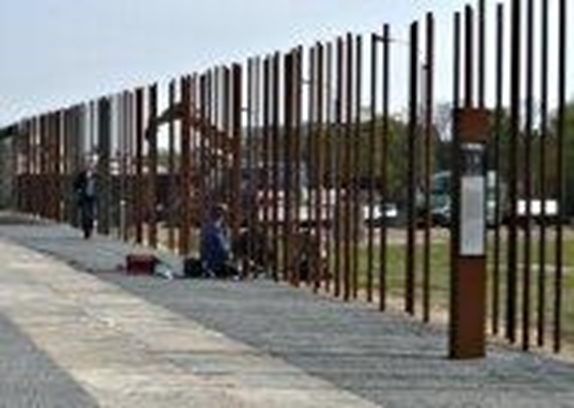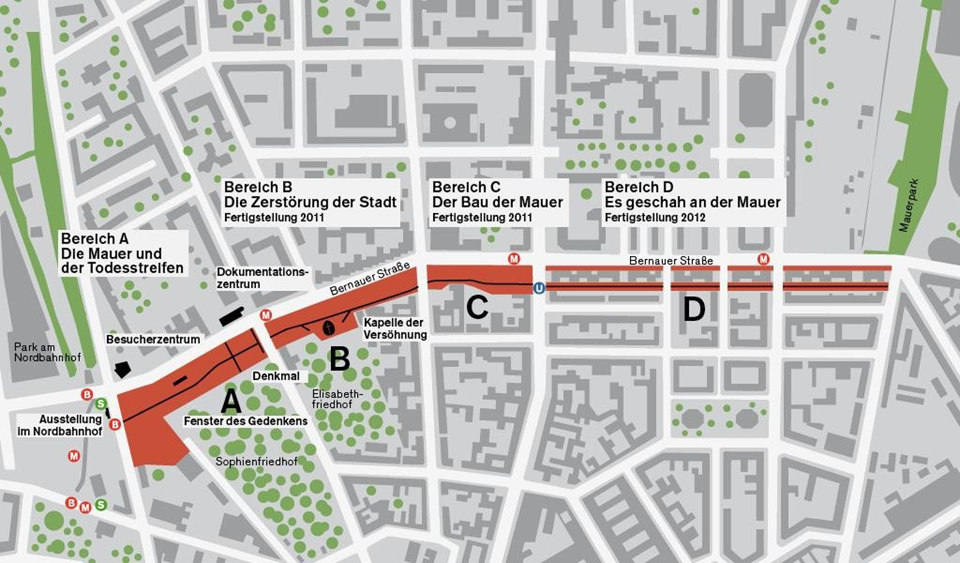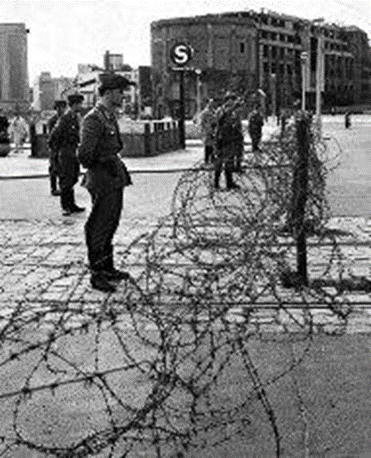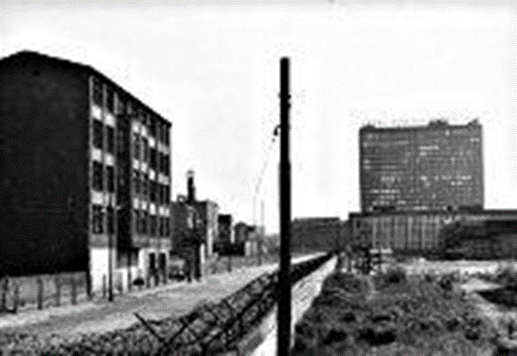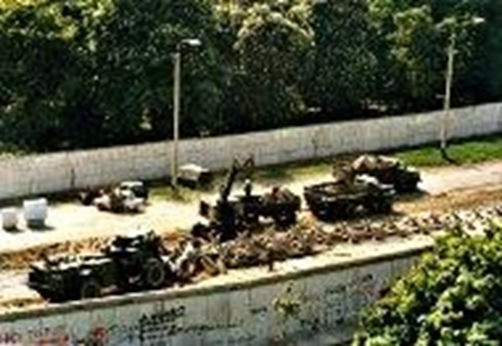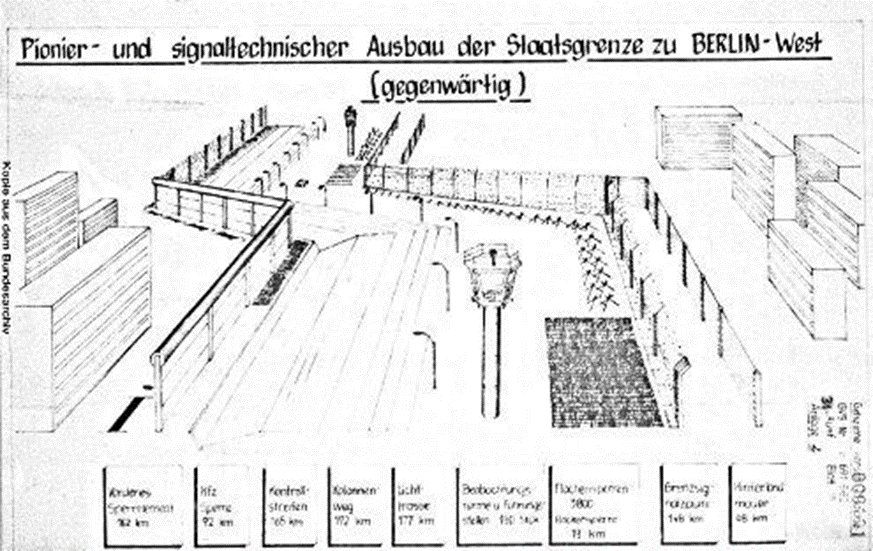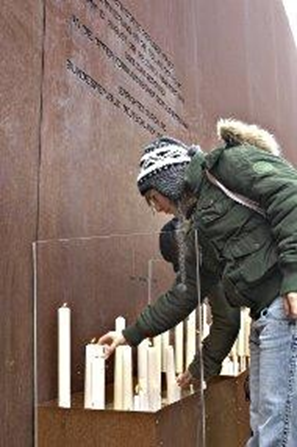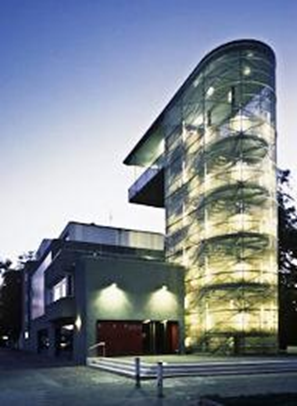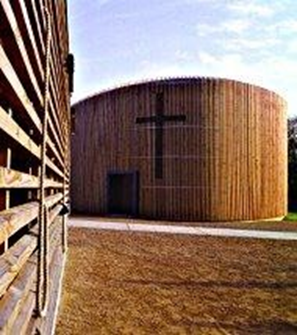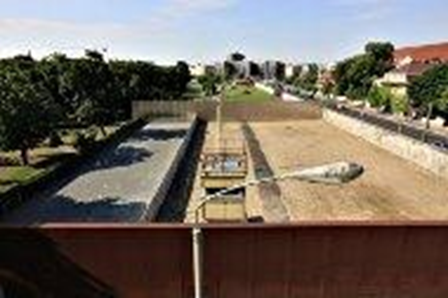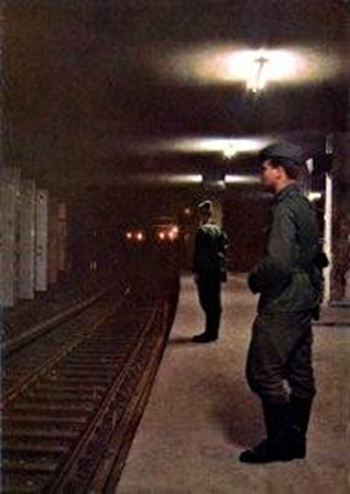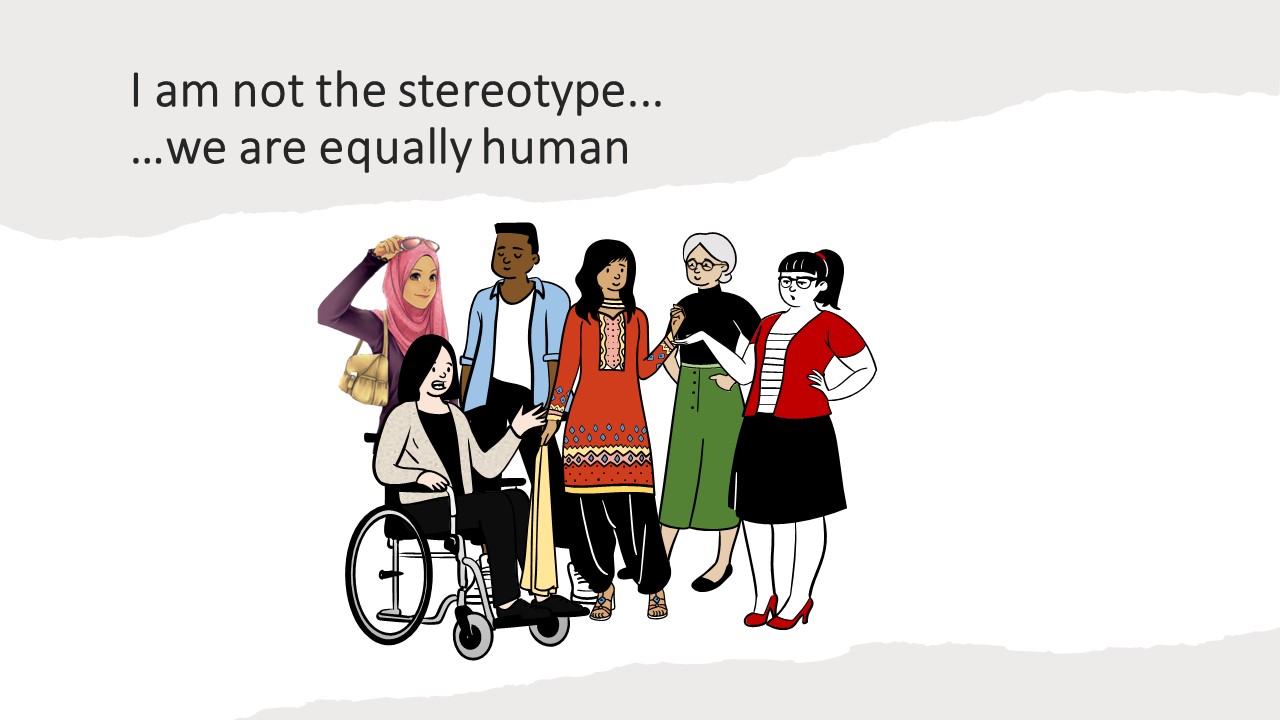The Berlin Wall Memorial is located in the historical site at the Bernauer Strasse in the middle of the capital. It is the central memorial in the German section. The last piece of the wall and the preserved grounds are the main contents that extend 1.4 km of the original wall used to prevent emigration from East Berlin to West Berlin in the period between 13th /August /1961 and 9th/November 1989. Both the memorial and the Marienfelde Refugee Centre Museum are encompassed by The Berlin Wall Foundation.
An open-air exhibition which is located on the border strip explains the history of division. The main features are the Monument in Memory of the Divided City and the Victims of Communist Tyranny in addition to the Window of Remembrance. Also, the grounds include the Chapel of Reconciliation and the foundations of a building its façade has been used as a wall border.
On the side of the street that used to be the western
part of the city the Visitor Center and the Documentation Center with a viewing platform are located. The Nordbahnhof S-Bahn station shows
the exhibition “Border Stations and Ghost Stations in Divided Berlin” inside (Berlin Wall Memorial
2017 website).
Figure 1: The Berlin wall, Provided by (Domaine public, CC0)
Figure 2: Marker showing where the Wall stood, 2010, Provided By: A. Klausmeier, Berlin Wall Memorial
Site Composition
The historical grounds consist of four exhibition categories:
- Corten steel will indicate the place where the original fortifications have been lost. Also, representations of escape tunnels and destroyed border buildings will be added.
- Incident markers explain certain incidents. A "field book" shows the details.
- Archaeological windows present previous fortifications of the border and traces that
were destroyed by the wall and the border strip.
- An exhibition on the border strip explains the historical events of the site (Berlin Wall Memorial 2017 website).
Figure 3: Map of the Memorial Grounds, Provided By: Berlin Wall Memorial 2017
- Area A: The Wall and the Death Strip
- Area B: The Destruction of the City
- Area C: Building the Wall
- Area D: Everyday life at the Wall (Berlin Wall Memorial 2017 website).
History of the Wall
As there was constant mass emigration from East Berlin to West Berlin the Soviet occupying forces (SED) started to close the East German border early in 1952 and on the 13th of August 1961 barbed wire has been
erected. Walls and wires did not stop the escape of people so the barriers were expanded and reinforced.
Figure 4: Sealing of the sector border, Potsdamer Platz, Aug. 13, 1961,
source: bpk-bildagentur.de| Alex Waidmann
The wall turned into a multi-layered complex border to stop the increasing continuous escape attempts. With every escape temporary, individual barriers were added at first and after establishing a border area behind the Wall in East Berlin by 1963, a fence sealed off this area. Then in the mid-sixties, the SED destroyed some buildings to bring a uniform border strip that would provide an "unobstructed view and clear field of fire." More barriers were added time and a second “inner wall” (Hinterlandmauer) was installed in the seventies.
The complex border in the early eighties included an inner wall, a fence with an alarm, observation towers occupied by soldiers who also watched the area of West Berlin that bordered the Wall, a carpet of steel spikes at the end of the fence pointed upwards, “tank traps” made of railroad tracks welded together and enveloped in barbed wire to stop escapes by vehicles, a ditch on the outer ring border and 12-foot-high border wall which is the last before reaching the West (Berlin Wall Memorial 2017 website).
To make the border even stronger in preventing escapes there were also dog runs and bright lines of lamps on it and both enclosing walls were painted white from the inside.
The border wall was rebuilt in the late seventies and metal gratings, bunkers and vehicle obstacles were removed by 1983 as the new Wall had a much better "blocking capacity" and the SED did not want the public image of the East German capital’s governed by the borders with threatening fortifications. By the late eighties, most of the fortifications were removed shortly before the Wall fell in 1989 (Berlin Wall Memorial 2017 website).
Figure 5: Wall and border strip before the reconstruction, Kreuzberg, 1978, Provided By: C. Wollmann-Fiedler, Berlin Wall Memorial
Figure 6: Removal of vehicle obstacles on the Sophien parish cemetery, 1985,
source: https://www.mauer-fotos.de/fotos/f-030996/
Figure 7: Sketch of the border fortifications drawn by the border troops, 1983,
source: https://www.stiftung-berliner-mauer.de/en/topics/berlin-wall
Causes to the State of Ruin
On 9th /November/1989, the Wall fell under the people`s onslaught as crowds rushed to the border once a new emigration law was falsely announced that citizens are allowed to travel.
After the border opened, “wall peckers” started the demolition of the Wall by breaking off pieces as souvenirs and the crossings increased leaving large gaps in the Wall. Other parts of the border fortifications were dismantled by the soldiers. Marketing the Wall was considered by the East German government and members of the border selling pieces of the wall
all over the world.
The border grounds started to be systematically dismantled between the districts of Wedding and Mitte at Ackerstrasse in June 1990. The first parts of the Wall were designated as a historical monument in 1990 (Berlin Wall Memorial 2017 website).
History of Memorial and Preservation
On October 2, 1990, the section of the border that ran through the Sophien parish cemetery was announced as a historical monument by the East Berlin magistrate.
In 1994, a design competition was made in the memory of the division dedicated to victims of the Wall.
In 1997, the Berlin Wall Association was created by the Berlin Senate initiative to supervise a documentation centre’s foundation that provides information and education. The dedication of The Chapel of Reconciliation was in 2000.
These three elements provide historical information about the Berlin Wall and its results on three different levels: artistically, factually, and spiritually.
In 2006 the Berlin Senate presented a "Masterplan to Preserve the Memory of the Berlin Wall" asking for linking of the different sites of the Berlin Wall because the left few pieces were meaningless after many fortifications were taken apart, the memorial on Bernauer Strasse has been founded as the central site to remember the victims. At the corner of Bernauer Strasse and Gartenstrasse, the Visitor Center opened in 2009 offering historical information to the visitors.
The open-air exhibit is located in the centre of the memorial on the south side of Bernauer Strasse. In 2010, The “Window of Remembrance,” which is the central part of the grounds of the former Sophien parish cemetery was completed dignifying the memorial site of the victims.
On November 9, 2014, the new permanent exhibition "1961 | 1989 The Berlin Wall" opened on the 25th anniversary of the fall of the Wall in the renovated documentation centre of the memorial providing information about the construction and the fall of the wall and the reunion of East and West Germany.
The monument is a preserved 70-meter long part of the original border fortifications enclosed by two steel walls and was dedicated on August 13, 1998, with an inscription that says: “In memory of the division of the city from August 13, 1961, to November 9, 1989, and in commemoration of the victims of Communist tyranny.” (Berlin Wall Memorial 2017 website).
Figure 8: A. Schölzel, Provided By: Berlin Wall Memorial
Figure 9: Viewing platform at the Documentation Center, Provided By: Berlin Wall Memorial
Figure 10: The Chapel of Reconciliation, 2002, source: C. Jungebl0odt, https://lepetitjournal.com/berlin/bernauer-strasse-rue-histoire-mur-321504
Figure 11: View over the monument and parts of the memorial
grounds, photo: J. Hohmuth, Provided By: Berlin Wall Memorial

Figure 12: Entrance to the Visitor Center of the Memorial, 2010,
source: http://withberlinlove.com/2012/04/09/gedenkstatte-berliner-mauer-berlin-wall-memorial/
Figure 13: Border soldiers guard the S-Bahn station at Potsdamer Platz, undated,
source: btsu.de
Measurements, Colour and Materials
The monument is a preserved 70-meter long part of the original border fortifications enclosed by two steel walls (Berlin Wall Memorial 2017 website).
Remains and traces of the Berlin Wall were preserved giving life to dramatic historical events. The wall stands with bare grey concrete as open-air museum on Bernauer Straße. The two steel walls parallel to each other which is meant to give the impression
of a never-ending wall have lost their shine (Smee, Jess, 2009).
Figure 14: The Berlin wall, Provided By: Berlin Wall Memorial 2017
Reflections on the Ruin
“The location may be authentic but the border fortifications are not complete”
(Knischewski and Spittler, 2006:285)
With this criticism, Knischewski and Spittler accused Bernauer Strasse of lacking authenticity.>
A spokesman for Berlin's culture ministry stated:
"There has not yet been a coherent concept for the Wall, just remains of it, scattered throughout the city,"
"It was probably a mistake to tear it down so enthusiastically in the early 1990s." (
Connolly, Kate, 2004)
Also, the historian Fredric Baker considered the wall memorial as a reconstruction more than an original as the poor condition of the wall needed refurbishment. However, Politics and experts certified Bernauer Strasse as authentic and by that, it was considered authentic.
The results include two points. Firstly, Bernauer Strasse was certified as the official central place for the Wall memorial because it was the “site of the events”.
"Preserving the wall at Bernauer Strasse will be more a work of reconstruction than of preserving
what is presently there”
(Baker, 1993: 729, section 5.21)
The second point was made by art historian Martin Schonfeld; he praised the official Berlin Wall memorials as being the products of a "factual and critical" democratically legitimized selection process:
"These artistic monuments of the Nineties cannot be instrumentalised for political or touristic performances… They do not feign authenticity but instead consider themselves to be a contemporary statement. They are thus a democratic culture of competition or art in the public space.”
(Quoted in “Tear down this Wall” 2005)
When it came to defending features of Bernauer Strasse, the critics presented a concept of authenticity that Cohen had described.
“Rather than being neutral reproductions, such attractions often embody the cultural values, ideological perspectives…,
or commercial interests … of their creators. They are in themselves “cultural productions” of
our own time.”
(Cohen, 1995: 20: Section 7.1.4)
With this argument, Bernauer Strasse can be considered authentic. It has been chosen by public competition and a site of remembrance that has been “reviewed” by experts and politicians (Frank, Sybille, 2015:210-214).
Opinion on Development of the Site
Although the services of the site were constantly developed to provide services and information about the site, the development would be more in the language of the current technology by using advancements such as animation to explain and engage the visitors by providing the information and experience of history.
References:
Baker, F., 1993. The Berlin Wall: production, preservation and consumption of a 20th-century monument. Antiquity, 67(257), pp.709-733.
Berlin Wall Memorial 2017 website, http://www.berliner-mauer-gedenkstaette.de/en/aufbau-der-grenzanlagen- 49.html, last accessed 18/12/2017, 8:39 AM:
Connolly, Kate, Crosswords over artist's memorial to Berlin Wall victims, The Telegraph, 29/11/2017 6:00 PM
Cohen, Erik (1995), ‘Contemporary Tourism - Trends and Challenges. Sustainable Authenticity or Contrived Post-modernity?’, in Richard W. Butler and Douglas G. Pearce (eds), Change in Tourism. People, Places, Processes, London, pp. 12-29.
Frank, Sybille, Wall Memorials and Heritage, Berlin, 2015:210-214.
Knischewski, G. and Spittler, U., 2006. Remembering the Berlin Wall: The Wall Memorial Ensemble Bernauer Strasse. German Life and Letters, 59(2), pp.280-293.
Lowry, R., Tear Down This Wall: The Reagan Revolution Paperback, Continuum International Publishing Group Ltd. 28 July 2005,
Smee, Jess, Berlin still divided on how to commemorate wall, Spiegel Online, 30/11/2017 8:21 AM

